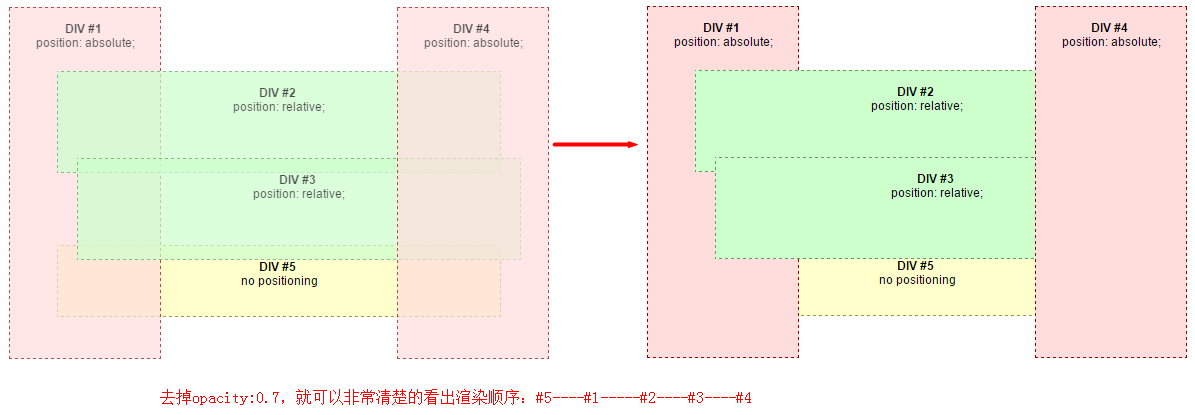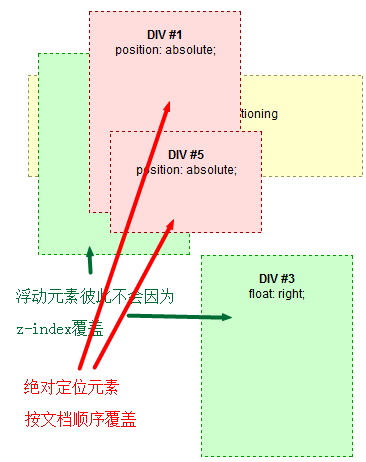一、z-index
z-index用來控制元素重疊時堆疊順序。
適用於:已經定位的元素(即position:relative/absolute/fixed)。
一般理解就是數值越高越靠上,好像很簡單,但是當z-index應用於複雜的HTML元素層次結構,其行為可能很難理解甚至不可預測。因為z-index的堆疊規則很複雜,下面一一道來。
首先解釋一個名詞:
stacking context:翻譯就是“堆疊上下文”。每個元素僅屬於一個堆疊上下文,元素的z-index描述元素在相同堆疊上下文中“z軸”的呈現順序。
z-index取值:
預設值auto:
當頁面新生成一個box時,它預設的z-index值為auto,意味著該box不會自己產生一個新的local stacking context,而是處於和父box相同的堆疊上下文中。
正/負整數
這個整數就是當前box的z-index值。z-index值為0也會生成一個local stacking context,這樣該box父box的z-index就不會和其子box做比較,相當於隔離了父box的z-index和子box的z-index。
接下來從最簡單的不使用z-index的情況開始將,循序漸進。
二、不使用 z-index時堆疊順序
不使用z-index的情況,也是預設的情況,即所有元素都不用z-index時,堆疊順序如下(從下到上)
- 根元素(即HTML元素)的background和borders
- 正常流中非定位後代元素(這些元素順序按照HTML文件出現順序)
- 已定位後代元素(這些元素順序按照HTML文件出現順序)
- 正常流中非positoned element元素,總是先於positioned element元素渲染,所以表現就是在positioned element下方,跟它在HTML中出現的順序無關。
- 沒有指定z-index值的positioned element,他們的堆疊順序取決於在HTML文件中的順序,越靠後出現的元素,位置越高,和position屬性無關。
例子:

<!DOCTYPE html> <html> <head> <meta charset="UTF-8"> <title>Stacking without z-index</title> <style type="text/css"> div { font: 12px Arial; text-align: center; } .bold { font-weight: bold; } .opacity{opacity: 0.7;} #normdiv { height: 70px; border: 1px dashed #999966; background-color: #ffffcc; margin: 0px 50px 0px 50px; } #reldiv1 { height: 100px; position: relative; top: 30px; border: 1px dashed #669966; background-color: #ccffcc; margin: 0px 50px 0px 50px; } #reldiv2 { height: 100px; position: relative; top: 15px; left: 20px; border: 1px dashed #669966; background-color: #ccffcc; margin: 0px 50px 0px 50px; } #absdiv1 { position: absolute; width: 150px; height: 350px; top: 10px; left: 10px; border: 1px dashed #990000; background-color: #ffdddd; } #absdiv2 { position: absolute; width: 150px; height: 350px; top: 10px; right: 10px; border: 1px dashed #990000; background-color: #ffdddd; } </style> </head> <body> <br /><br /> <div id="absdiv1" class="opacity"> <br /><span class="bold">DIV #1</span> <br />position: absolute; </div> <div id="reldiv1" class="opacity"> <br /><span class="bold">DIV #2</span> <br />position: relative; </div> <div id="reldiv2" class="opacity"> <br /><span class="bold">DIV #3</span> <br />position: relative; </div> <div id="absdiv2" class="opacity"> <br /><span class="bold">DIV #4</span> <br />position: absolute; </div> <div id="normdiv"> <br /><span class="bold">DIV #5</span> <br />no positioning </div> </body> </html>
有圖有真相:

分析:
#5沒有定位,處於正常流,所以根據以上規則,先於#1,#2,#3,#4這些已定位元素渲染,在最下方。
#1,#2,#3,#4都是已定位元素,且未設定z-index,所以根據其在文件中出現的順序依次被渲染,可以去掉apacity檢視清晰效果。
三、浮動堆疊順序
浮動元素z-index位置介於非定位元素和定位元素之間。(從下到上)
- 根元素(即HTML元素)的背景和border
- 正常流中非定位後代元素(這些元素順序按照HTML文件出現順序)
- 浮動元素(浮動元素之間是不會出現z-index重疊的)
- 正常流中inline後代元素
- 已定位後代元素(這些元素順序按照HTML文件出現順序)
non-positioned元素的背景和邊界沒有被浮動元素影響,但是元素中的內容受影響(浮動佈局特性)
舉例:

<!DOCTYPE html> <html> <head> <meta charset="UTF-8"> <title>Stacking and float</title> <style type="text/css"> div { font: 12px Arial; text-align: center; } .bold { font-weight: bold; } .opacity{ opacity: 0.7;} #absdiv1 { position: absolute; width: 150px; height: 200px; top: 10px; right: 140px; border: 1px dashed #990000; background-color: #ffdddd; } #normdiv { /* opacity: 0.7; */ height: 100px; border: 1px dashed #999966; background-color: #ffffcc; margin: 0px 10px 0px 10px; text-align: left; } #flodiv1 { margin: 0px 10px 0px 20px; float: left; width: 150px; height: 200px; border: 1px dashed #009900; background-color: #ccffcc; } #flodiv2 { margin: 0px 20px 0px 10px; float: right; width: 150px; height: 200px; border: 1px dashed #009900; background-color: #ccffcc; } #absdiv2 { position: absolute; width: 150px; height: 100px; top: 130px; left: 100px; border: 1px dashed #990000; background-color: #ffdddd; } </style> </head> <body> <br /><br /> <div id="absdiv1" class="opacity"> <br /><span class="bold">DIV #1</span> <br />position: absolute; </div> <div id="flodiv1" class="opacity"> <br /><span class="bold">DIV #2</span> <br />float: left; </div> <div id="flodiv2" class="opacity"> <br /><span class="bold">DIV #3</span> <br />float: right; </div> <br /> <div id="normdiv"> <br /><span class="bold">DIV #4</span> <br />no positioning </div> <div id="absdiv2" class="opacity"> <br /><span class="bold">DIV #5</span> <br />position: absolute; </div> </body> </html>

分析:
#4是正常流中非定位的元素,所以先被渲染,在最底層。
#2 #3一個左浮動,一個右浮動,接著被渲染。彼此不會因為z-index值被覆蓋。見下圖。
#1 #5為已定位的元素,最後被渲染,當瀏覽器視窗變小時,#5在#1上面,因為HTML文件中#5在#1後面。見下圖。

四、z-index
預設的堆疊順序上面說了,要想改變 元素的堆疊順序就得用到z-index。
Note:前兩種情況中,雖然有元素之間的重疊覆蓋,但是它們都是處在同一個z-layer的。因為沒有設定z-index屬性,預設的渲染層就是layer 0。所以要注意,不同層中元素之間覆蓋是理所當然的,但是同一層中的元素也會發生覆蓋。
z-index只適用於已經定位的元素(即position:relative/absolute/fixed)。
舉例:

<!DOCTYPE html> <html> <head> <meta charset="UTF-8"> <title>Stacking without z-index</title> <style type="text/css"> div { font: 12px Arial; text-align: center; opacity: 0.7; } .bold { font-weight: bold; } #normdiv { z-index: 8; height: 70px; border: 1px dashed #999966; background-color: #ffffcc; margin: 0px 50px 0px 50px; } #reldiv1 { z-index: 3; height: 100px; position: relative; top: 30px; border: 1px dashed #669966; background-color: #ccffcc; margin: 0px 50px 0px 50px; } #reldiv2 { z-index: 2; height: 100px; position: relative; top: 15px; left: 20px; border: 1px dashed #669966; background-color: #ccffcc; margin: 0px 50px 0px 50px; } #absdiv1 { z-index: 5; position: absolute; width: 150px; height: 350px; top: 10px; left: 10px; border: 1px dashed #990000; background-color: #ffdddd; } #absdiv2 { z-index: 1; position: absolute; width: 150px; height: 350px; top: 10px; right: 10px; border: 1px dashed #990000; background-color: #ffdddd; } </style> </head> <body> <br /><br /> <div id="absdiv1"> <br /><span class="bold">DIV #1</span> <br />position: absolute; <br />z-index: 5; </div> <div id="reldiv1"> <br /><span class="bold">DIV #2</span> <br />position: relative; <br />z-index: 3; </div> <div id="reldiv2"> <br /><span class="bold">DIV #3</span> <br />position: relative; <br />z-index: 2; </div> <div id="absdiv2"> <br /><span class="bold">DIV #4</span> <br />position: absolute; <br />z-index: 1; </div> <div id="normdiv"> <br /><span class="bold">DIV #5</span> <br />no positioning <br />z-index: 8; </div> </body> </html>

五、stacking context
為什麼上個例子中元素的堆疊順序受z-index的影響呢?因為這些元素有些特殊的屬性觸發它們生存堆疊上下文(stacking context)。
問題來了,什麼樣的元素會生成堆疊上下文呢?符合下面規則之一的:
- 根元素(即HTML元素)
- 已定位元素(即絕對定位或相對定位)並且z-index不是預設的auto。
- a flex item with a z-index value other than "auto",
- 元素opacity屬性不為1(See the specification for opacity)
- 元素transform不為none
- 元素min-blend-mode不為normal
- 元素filter屬性不為none
- 元素isolation屬性為isolate
- on mobile WebKit and Chrome 22+,
position: fixedalways creates a new stacking context, even when z-index is "auto" (See this post) - specifing any attribute above in
will-change - elements with
-webkit-overflow-scrollingset to "touch"
在堆疊上下文(stacking context)中 ,子元素的堆疊順序還是按照上述規則。重點是,子元素的z-index值只在父元素範圍內有效。子堆疊上下文被看做是父堆疊上下文中一個獨立的模組,相鄰的堆疊上下文完全沒關係。
總結幾句:
渲染的時候,先確定小的stacking context中的順序,一個小的stacking context確定了以後再將其放在父stacking context中堆疊。有種由內而外,由小及大的感覺。
舉例:HTML結果如下,最外層是HTML元素,包含#1 #2 #3,#3中又包含著#4,#5,#6。
Root(HTML)
- DIV #1
- DIV #2
- DIV #3
- DIV #4
- DIV #5
- DIV #6

<!DOCTYPE html PUBLIC "-//W3C//DTD XHTML 1.0 Strict//EN" "http://www.w3.org/TR/xhtml1/DTD/xhtml1-strict.dtd"> <html xmlns="http://www.w3.org/1999/xhtml" xml:lang="en"> <head> <title>Understanding CSS z-index: The Stacking Context: Example Source</title> <style type="text/css"> * { margin: 0; } html { padding: 20px; font: 12px/20px Arial, sans-serif; } div { opacity: 0.7; position: relative; } h1 { font: inherit; font-weight: bold; } #div1, #div2 { border: 1px solid #696; padding: 10px; background-color: #cfc; } #div1 { z-index: 5; margin-bottom: 190px; } #div2 { z-index: 2; } #div3 { z-index: 4; opacity: 1; position: absolute; top: 40px; left: 180px; width: 330px; border: 1px solid #900; background-color: #fdd; padding: 40px 20px 20px; } #div4, #div5 { border: 1px solid #996; background-color: #ffc; } #div4 { z-index: 6; margin-bottom: 15px; padding: 25px 10px 5px; } #div5 { z-index: 1; margin-top: 15px; padding: 5px 10px; } #div6 { z-index: 3; position: absolute; top: 20px; left: 180px; width: 150px; height: 125px; border: 1px solid #009; padding-top: 125px; background-color: #ddf; text-align: center; } </style> </head> <body> <div id="div1"> <h1>Division Element #1</h1> <code>position: relative;<br/> z-index: 5;</code> </div> <div id="div2"> <h1>Division Element #2</h1> <code>position: relative;<br/> z-index: 2;</code> </div> <div id="div3"> <div id="div4"> <h1>Division Element #4</h1> <code>position: relative;<br/> z-index: 6;</code> </div> <h1>Division Element #3</h1> <code>position: absolute;<br/> z-index: 4;</code> <div id="div5"> <h1>Division Element #5</h1> <code>position: relative;<br/> z-index: 1;</code> </div> <div id="div6"> <h1>Division Element #6</h1> <code>position: absolute;<br/> z-index: 3;</code> </div> </div> </body> </html>
效果:

分析一下:
1、因為設定了div {opacity: 0.7; position: relative;},所以#1~#6的z-index都是有效的。
2、為什麼#4的z-index比#1高,但是卻在#1下面?因為#4的z-index雖然值大,但它的作用域在包含塊#3內,而#1的z-index的作用域在html內,和#3同屬html,而#3的z-index小於#1。
3、為什麼#2的z-index值比#5的大,還在下面?同上。
4、#3的z-index是4,但該值和#4,#5,#6的z-index不具有可比性,它們不在一個上下文環境。
5、如何輕易的判斷兩個元素的堆疊順序?
z-index對堆疊順序的控制類似於排版時候一大章下幾個小節的樣子,或者版本號中一個大的版本號跟著小版本號。
Root-z-index值為預設auto,即0
- DIV #2 - z-index 值為2
- DIV #3 - z-index 值為4
- DIV #5 - z-index值為 1,其父元素z-index值 4,所以最終值為4.1
- DIV #6 - z-index值為 3,其父元素z-index值 4,所以最終值為4.3
- DIV #4 - z-index值為 6,其父元素z-index值 4,所以最終值為4.6
- DIV #1 - z-index 值為5
想看更多例子,可參考文章最後的資源連結。
六、 合理使用z-index數值
如果現有三個堆疊的層,從上到下分別為:DIV3,DIV2,DIV1,設定時以100為間隔,設定DIV1的z-index為0,DIV2的z-index為100,設定DIV3的z-index為200。這樣後期如果需要在DIV1和DIV2之間加入一些層的話,以10為間隔,設定z-index為10,20等。再需要向z-index0和z-index10之間加入一層的話以5為間隔。這樣的寫法可以方便後期擴充套件新增內容。
儘量避免給z-index使用負值。當然不是絕對的,比如在做圖文替換的時候可以使用負值。
七、資源連結
- Stacking without z-index : Default stacking rules
- Stacking and float : How floating elements are handled
- Adding z-index : Using z-index to change default stacking
- The stacking context : Notes on the stacking context
- Stacking context example 1 : 2-level HTML hierarchy, z-index on the last level
- Stacking context example 2 : 2-level HTML hierarchy, z-index on all levels
- Stacking context example 3 : 3-level HTML hierarchy, z-index on the second level
本文作者starof,因知識本身在變化,作者也在不斷學習成長,文章內容也不定時更新,為避免誤導讀者,方便追根溯源,請諸位轉載註明出處:http://www.cnblogs.com/starof/p/4424926.html有問題歡迎與我討論,共同進步。
